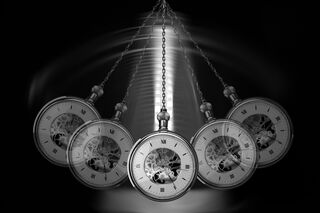Hypnosis
What Is Erotic Hypnosis—and Does It Work?
Erotic recordings can play a part in exploring secret sexual desires.
Posted January 17, 2022 Reviewed by Devon Frye
Key points
- Hypnosis remains a complex, controversial phenomenon, reflecting increased suggestibility.
- Eroticism plays a significant component in many forms of hypnosis.
- Research suggests that erotic hypnosis is most likely a means for viewers to explore sexual desires they find fearful and shameful.

If you’ve ever attended a stage hypnotism show, chances are good that the show included some racy, sexy content. I once watched a show where two women seated at my table participated in an on-stage activity the hypnotist called “Butt Bongos.” You can probably imagine what the activity involved. The fascinating thing was that one of the women reported that she had felt extremely relaxed, and under a spell, and wasn’t even really sure if things on stage were real, or imagined. In contrast, the other woman explained that she went along with the game, because it was fun, but she never felt anything other than excitement at being on stage. Many such hypnosis demonstrations also involve hypnotically triggering orgasms in seemingly unsuspecting subjects, following the implantation of an unconscious or “preconscious” trigger.
There are simply huge numbers of erotic hypnosis videos on sites such as YouTube, where there are many thousands of videos with millions of views. “Hands-free orgasms” and “orgasms on command” are some of the most popular, mimicking the popular component of stage acts. Other videos claim to turn watchers into sex slaves, or make them into “sissies,” or feminized males who engage in sexual behaviors not consistent with their (conscious) sexual orientations.
Hypnosis itself is controversial, as to what it actually is. Is it a form of heightened suggestion, a trance, or a form of mind control? The U.S. military abandoned its usefulness as a means to exert mind control or extract information, in contrast to the movie The Manchurian Candidate. Some people are more susceptible to hypnotizability, though this hypnotizability doesn’t necessarily predict how people will respond to hypnotic interventions.

During the satanic ritual abuse, multiple personality disorder, and recovered memory movements, clinical hypnosis was often used by therapists in order to uncover other personalities, recover lost memories, and expose hidden cult abuses. Research examining these processes demonstrated that these techniques were prone to creating false memories, and as a result, many courts forbade testimony based on hypnotically-recovered memories. In modern clinical hypnosis, current evidence supports hypnosis' value in some limited medical roles, particularly involving pain management. Whether real or not, hypnosis may influence some peoples’ beliefs about their experiences, and selves.
What About Erotic Hypnosis?
Can hypnosis then cause people to experience involuntary orgasms? Can it lead to them engaging in behaviors that they would not otherwise? The answer is complicated—not surprising, given the complexity of hypnosis itself.
Mackay and Mackay recently published a review of these issues, describing “viewers claiming to have been ‘irreversibly altered’ by viewing sissy hypno,” and who believed that such videos "did make me trans." However, Mackay and Mackay suggest that these erotic videos are, in the main, more akin to stage hypnotism and a form of brainwashing, rather than true hypnotic endeavors. They note that erotic hypnosis is often entwined with the practice of bondage, discipline, sadism, and masochism (BDSM), where an individual gives up power to another person, for erotic purposes. Erotic hypnosis can then be a form of opening oneself up to control and direction from a dominant person who uses erotic hypnosis as a strategy to give sexual instructions. Eric Chambers conducted a dissertation study of the ways erotic hypnosis was used in an online discussion in males exploring different levels of power and agency in same-sex sexual fantasies.
Mackay and Mackay suggest that a key component of the draw of these erotic media lies in the role of sexual shame and disgust, and offering viewers a way to overcome their internal barriers towards engaging in desired sexual behaviors. They suggest that many viewers intentionally create an internal conflict between their desires and feelings of shame. "The idea of hypnosis, in this reading, provides a convenient way for the viewer to subconsciously externalize the "blame" for their own self-disgust, something that might find a corollary in the idea of "pornography addiction," which, although lacking scientific evidence, is nonetheless persistently put forward as an explanation for overuse of easily available online porn. In both cases...pornography is experienced or imagined as an outside force that takes over the blameless viewer’s brain, effectively forcing them through the barrier of shame without the need for a shameless parade of transgression." (Mackay & Mackay, 2022)
In my clinical practice, I’ve seen individuals who use pseudohypnotic strategies as a form of seduction and soothing during sexual interactions, a clever form of role play. On the other side, I’ve seen individuals with severe sexual conflicts and extreme anxiety and obsessiveness who become immersed in such videos and find themselves confused and frightened, unable to clearly define their own erotic selves.
For some, such erotic videos are a form of entertainment, where viewers play along, like my friend on stage. But for others, these erotic recordings may provide a context where the individual may relax, and “the hypnosis fantasy, rooted in the hypnotic affect of online porn watching, may allow for creative experimentation that admits the polysemy of desire.” (Mackay and Mackay 2022) These videos are unlikely to give you the ability to orgasm on command, but may help you to relax and accept the things which you find sexually arousing.


